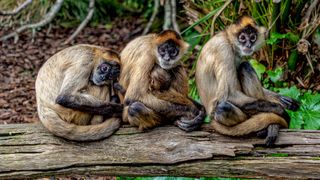
Do animals hug each other?
Who else is fond of a warm embrace?

COVID-19 interrupted one of life's most familiar acts: the warm, enveloping comfort of a hug. The pandemic taught us many things, some more important than others — but one of those is just how much many of us rely on these embraces for a sense of reassurance, consolation and calm.
We've become profoundly aware of the significance of this simple act in our human lives — but does hugging exist in the rest of the animal kingdom? Are there any other species that embrace in the way humans do?
To answer that, first we have to define exactly what we mean by "hug." From a subjective human standpoint, of course, a hug happens when someone wraps their arms around someone else. Naturally, this restricts hugging to animals with arms — and those are mainly primates, like us. This quickly reveals that, while we might see hugs as a uniquely human trait, hugging is actually just as prominent in the lives of nonhuman primates.
Related: Do any animals know their grandparents?
Comfort and consolation
Take, for example, bonobos (Pan paniscus), which are often described as the peace-loving hippies of the primate world. These primates have been a lifelong subject of study for Zanna Clay, a comparative and developmental psychologist and primatologist at Durham University in the United Kingdom. Clay studies social interactions among bonobos, and much of her observational work takes place at a sanctuary in the Democratic Republic of the Congo for bonobos whose lives have been disrupted by hunting. At this sanctuary, it's common to see troops of infants obsessively clinging to one another as they walk around in tandem.
"You have quite a lot of young orphans who need quite a lot of reassurance, and they do what we call the 'hug walk': They hug together and walk along in a little train," Clay told Live Science.
Clay says that this behavior is more common in the sanctuary than it would be in the wild — possibly because bonobos are also exposed to embraces from their human caregivers — but it still does occur in bonobos' natural lives. In fact, this behavior probably has roots in the maternal behavior of female bonobos, which cradle their infants when they are small. Researchers have observed that this hugging behavior is most common in young bonobos and typically occurs after a bonobo has experienced conflict or stress. Often, in these cases, a distressed bonobo will stretch out its arms in a beseeching gesture, and another bonobo will dramatically rush toward the squealing infant and encircle it in a tight embrace.
Sign up for the Live Science daily newsletter now
Get the world’s most fascinating discoveries delivered straight to your inbox.
"A bonobo might request [a hug], so they will seek someone out and sort of ask for help, or somebody might offer them one," Clay said.

It's difficult to judge animal emotions, but the evidence points to the likelihood that hugging reassures these primates, just as it does humans, Clay said. Intriguingly, in some of her previous research, Clay and her colleagues discovered that orphaned bonobos were less likely to offer sympathetic hugs to distressed peers, compared with young bonobos that had been reared by their mothers. This might indicate the importance of parental care in laying the foundation for this social gesture in primates, Clay said.
Bonobos may be particularly fond of a good cuddle, but the maternal roots of this embrace make this behavior common across many other primate species. In many of these species, mothers hold their infants closely for extended periods of their infancy.
For instance, chimpanzees (Pan troglodytes) — bonobos' close relatives — are also known to embrace. This is especially notable in tense situations such as "border patrols," when chimps rove around to assert their presence and protect their territories, Clay said.
"If they hear a predator, or another chimpanzee group, or something scary, that's when you'll see them touching each other and holding on to each other," Clay said. The hug seems to function as reassurance in the face of danger, Clay added — another relatable feature for humans, who typically reach for one another when afraid.
Related: Do animals ever get sunburned?
In the case of crested black macaques (Macaca nigra), which live in Indonesia, hugging comes with an added flourish: These monkeys request hugs by audibly smacking their lips — an invitation that's not reserved for family but extended generously to other members of the troop.
In addition, young orangutans have been observed rushing to hug each other when confronted with the threat of a snake, thus emphasizing the hug's apparently reassuring role in times of stress or fear. And in another macaque species, the Tonkean macaque (Macaca tonkeana), researchers have discovered that consoling hugs are plentiful after a fight — and may even be accompanied by a kiss.
Proactive peacekeeping
Most research on hugging in primates focuses on its assumed role in reassuring and consoling others — which makes sense, because this mirrors what hugs mean to humans. But research on the lives of spider monkeys reveals a different reason primates engage in these seemingly affectionate displays.
Filippo Aureli is an ethologist — someone who studies animal behavior — and is affiliated with both the Universidad Veracruzana in Mexico and Liverpool John Moores University in the United Kingdom; he studies how spider monkeys use hugging not to recover from conflict but rather to prevent it. In research based on weeks of observing spider monkeys in the tropical forests of Mexico's Yucatán Peninsula, he discovered that these primates approach each other and embrace more in scenarios in which tensions threaten to boil over into conflict — for instance, when two monkey subgroups meet after a long time apart and fuse to form a larger troop.
"The embrace is done by individuals that have a problematic relationship," said Aureli, who is an editor on a book about conflict resolution in animals. "They may need to be together, and they may need to cooperate — but they are not best friends. And so, the embrace is a way to send a signal and really manage that conflicted relationship." He explained that because an embrace involves a high degree of vulnerability — after all, one animal is fully exposing its body to another — this "helps to clarify, 'Hey, I come with good intentions.'"
Related: Do animals laugh?
It's possible that hugging as a means of proactive damage control occurs in other primates, as well. But currently, spider monkeys are the best-studied example of this aspect of the behavior, Aureli said. He described their embraces as "preemptive peacemaking," and his study even suggests that humans could learn a thing or two from these careful creatures about how to manage conflict. "It's much better to prevent than to repair," Aureli said.

Speaking of humans, how do our own hugs compare to those of other primates? "At the end of the day, we are primates, and affiliative contact is a superimportant component of our social life," Clay said. "So, to me, there's obvious continuity in some of the functions of embracing and hugging with humans."
As in nonhuman primates, being held and embraced by our parents in our infancy sets us up for the reassuring, consoling function that hugs play in our lives. According to Clay, the one notable difference between our hugs and those of our primate kin is that humans seem to have layered more social symbolism onto the embrace. "I think the difference is that with humans, it's become a kind of conventionalized greeting or parting gesture," Clay said. "Apes don't tend to do that."
Beyond primates
Of course, we have to be careful not to assume that hugging looks the same in other species as it does in humans. Hugs in primates are easy to identify because they look like ours, but other species may have hugs that appear different.
"If we identify the function of a hugging embrace, then really, the form could be completely different — maybe less fascinating for us as humans, because we don't recognize it," Aureli said. "But it could basically fulfill the same role."
Primate studies indicate that embraces function to bond, reassure, console and make peace, but hugs could have myriad analogues in other animals. For example, horses groom one another, and studies reveal that this activity decreases their heart rates — a hallmark of comfort and calm. Researchers have observed that if the prairie vole (Microtus ochrogaster) detects signs of distress in its mate, it will rush over and rapidly start grooming the mate's fur; researchers have interpreted this behavior as a possible act of consolation. In birds, preening between pairs is thought to increase social bonds.
Lions (Panthera leo) rub heads and nuzzle, which is believed to boost their social connections. Hundreds of other mammal species lean against, nestle and huddle with one another to provide comfort and warmth, or to form a united front against danger — which might play a similar role to the steadying hug we see in primates. Meanwhile, dolphins seem to display a kind of consoling peacemaking behavior: Studies show that these cetaceans are more likely to engage in reconciliatory activities after a conflict — for instance, giving each other a flipper rub, or gently towing each other through the water, like an apologetic piggyback.
So, after the separation and stress brought on by the COVID-19 pandemic, we might take heart in knowing that what humans know as a hug could have many equivalents in our fellow animals. All around the world, there are animals carrying out small acts of comfort and consolation, and making difficult situations a bit easier for one another. That thought is almost as comforting as a big, cozy hug itself.
Originally published on Live Science.

Emma Bryce is a London-based freelance journalist who writes primarily about the environment, conservation and climate change. She has written for The Guardian, Wired Magazine, TED Ed, Anthropocene, China Dialogue, and Yale e360 among others, and has masters degree in science, health, and environmental reporting from New York University. Emma has been awarded reporting grants from the European Journalism Centre, and in 2016 received an International Reporting Project fellowship to attend the COP22 climate conference in Morocco.
